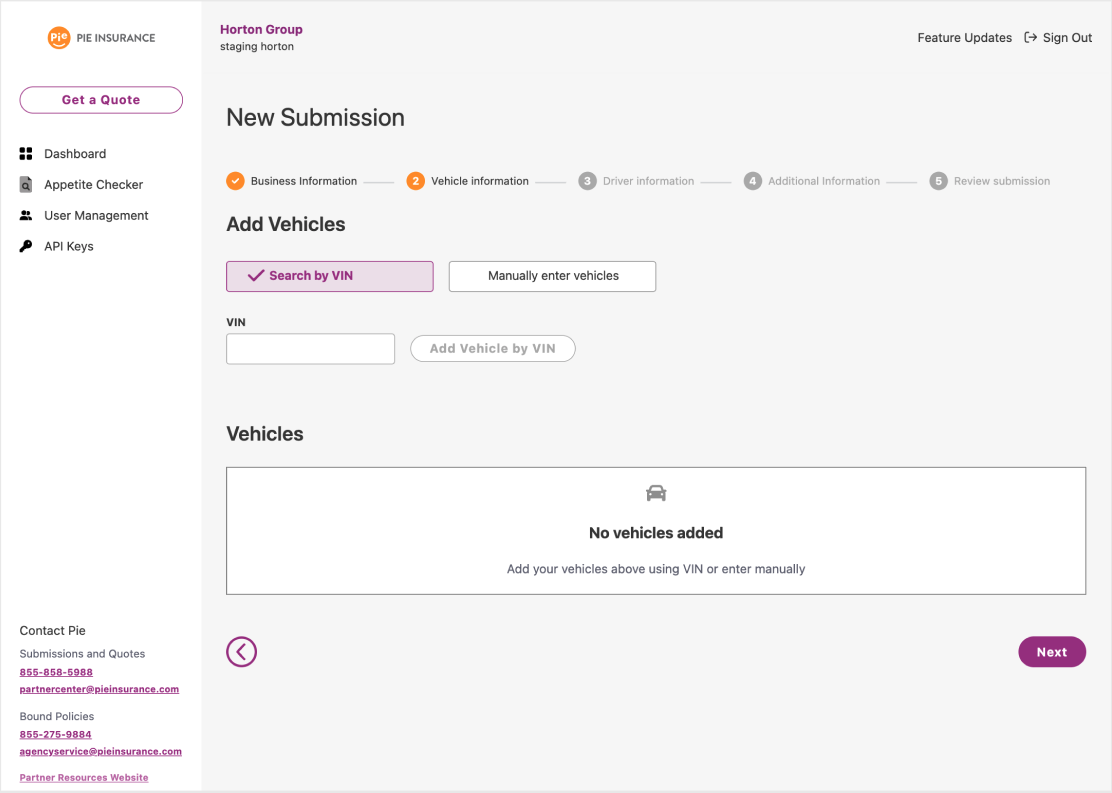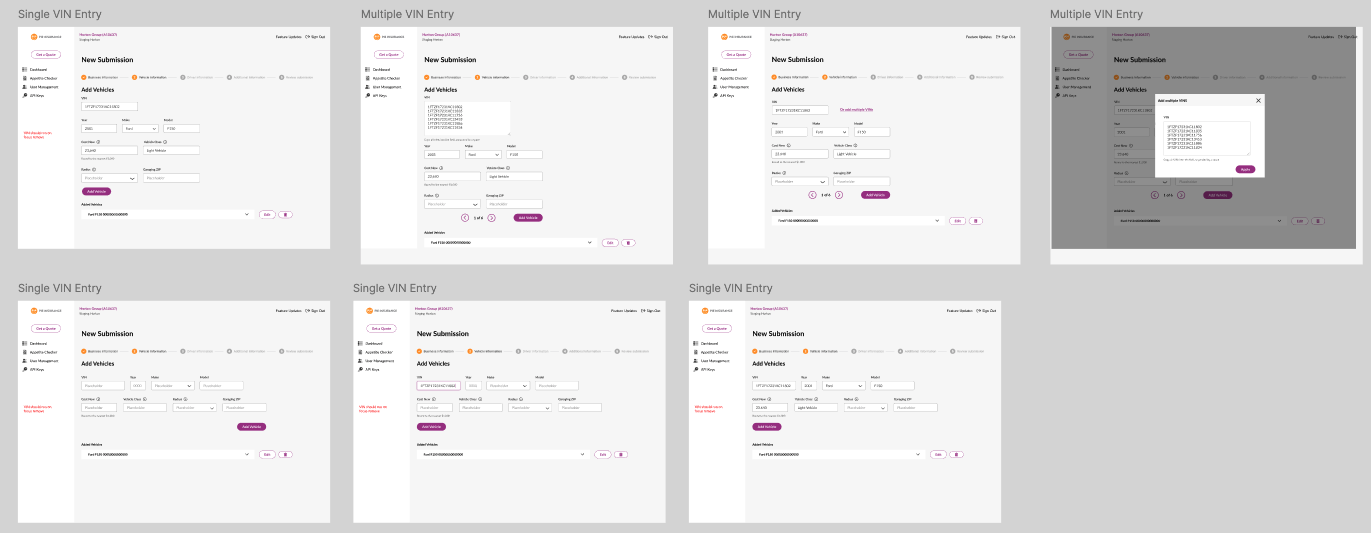It may not look like much, but it saves a bunch of time.
Bulk VIN Upload: Make quoting fleets easier
The Project:
The goal of the project was to make the quote process of a fleet of vehicles easier and faster, while also addressing some other UX concerns in the process.
At this point in Pie’s commercial auto journey, we were looking for larger fleets to quote. The original system was designed for a submission with roughly 10 or less vehicles for the business (average was around 3 at that time). We would occasionally get larger fleets and the system was designed to have you input one vehicle at a time, resulting in those submissions taking hours to input. The secondary issue is that our system would time out if you were on a specific page for too long, which meant these long submissions would be submitted in parts and an analyst would have to stitch them together on the back end. The problem I sought to answer was how to make this easier to submit a fleet quote that wouldn’t time out the system.
Additionally, we had heard that agents were missing fields that we had added as part of the lower table
My Role:
For this project I had the responsibilities of a Concept Designer, Project Manager, and UX Designer.
The Process:
Unlike a lot of other projects, this one started out as a solo project. I had heard from the internal associates that had to input the data in these cases how awful this process was, and the hours that it took. There was also frustration when our system would time out, thereby erasing all of their work.
The prior experience
We had already built out the ability to search by a vehicle’s VIN to pull the car’s data or to manually enter the vehicle if you didn't have the VIN. The challenge was that we made you enter in the vehicles one by one. And as you can see in the image you then had to go down to the vehicle table to select the garage and zip and the radius. This becomes especially problematic when you have a fleet of vehicle.
Initial Concept
Here you can see the original sketch that I worked on just to get a few ideas out of my head. I was playing around with layouts and starting to think about how you would view multiple vehicles particularly if we didn't have all of the information available for a vehicle. We would need someway to review the vehicles themselves. This were the concept screens that I shared with my engineering team as a fun idea
Simple layout concepts and enough of the process to share with the engineering team.
Hackathon
Pie insurance decided to hold its first hackathon and we were debating what we wanted to work on. The engineering team reached out to me and asked if they could try to build the bulk VIN upload as their project. I agreed, but still needed to hammer out some of the details
I wanted to make sure that the final concept followed the following parameters:
It had to be easy to scroll through the full list of vehicles. This meant trying to make it scannable and preferably one line of content
You had to be able to review and update the vehicles to make sure that all of the information was correct
We had to make it easy for the agent to add the garaging ZIP and radius to the fleet of vehicles as our VIN service couldn’t pull that data
We were able to complete all of those items and even added some user enhancements such as a skeleton loader when the VIN service was pulling the information on the vehicle, as well as the count of the vehicles so that the agent could compare what was expected to make sure no vehicles were missed.
I only have a few screens for the design as this was a hackathon and we were constantly communicating through the build as to what the experience would be. We also brought in one of our internal agents to review the screens, so the virtual post-it notes are questions/concerns we had from them
UX Testing:
After the hackathon, the project was about 80% built, but not on the roadmap at that point. The internal Commercial Auto team was super excited about rolling this out as it would reduce their input time of these fleets by hours. I worked with my product manager to try to carve out some time to get this rolled out.
In the mean time, we were able to launch the functionality in our test environment and run it through real submissions from the commercial auto team to see where there were gaps. This was mostly in the messaging around ineligible vehicles and if there wasn’t sufficient data on a VIN.
We also got feedback that most of the time, the agents don’t need to see all of the individual points of each vehicle, if we received all of the information. The decision was made to make each row in the table an accordion style with the most important info (year, make, model, and VIN) on display.
While we were building this out, the team got another fleet request in. I was able to work with the team to run the submission in our test environment, then extract it to put it into the system they were using at the time. It was a great stress test of the flow before rolling out out to our agents.
Final Mocks
The final design was release and got immediate fanfare from the team. We were seeing it used even on smaller fleets of vehicles and saving the team time when inputting these vehicles. You can see a video of the flow below.
final Results
The design was well received by the team, saving them hours when dealing with these larger fleets. It also allowed our internal team to guide our agents to self-service smaller to mid-size fleets and free up our internal team to better serve our customers.







